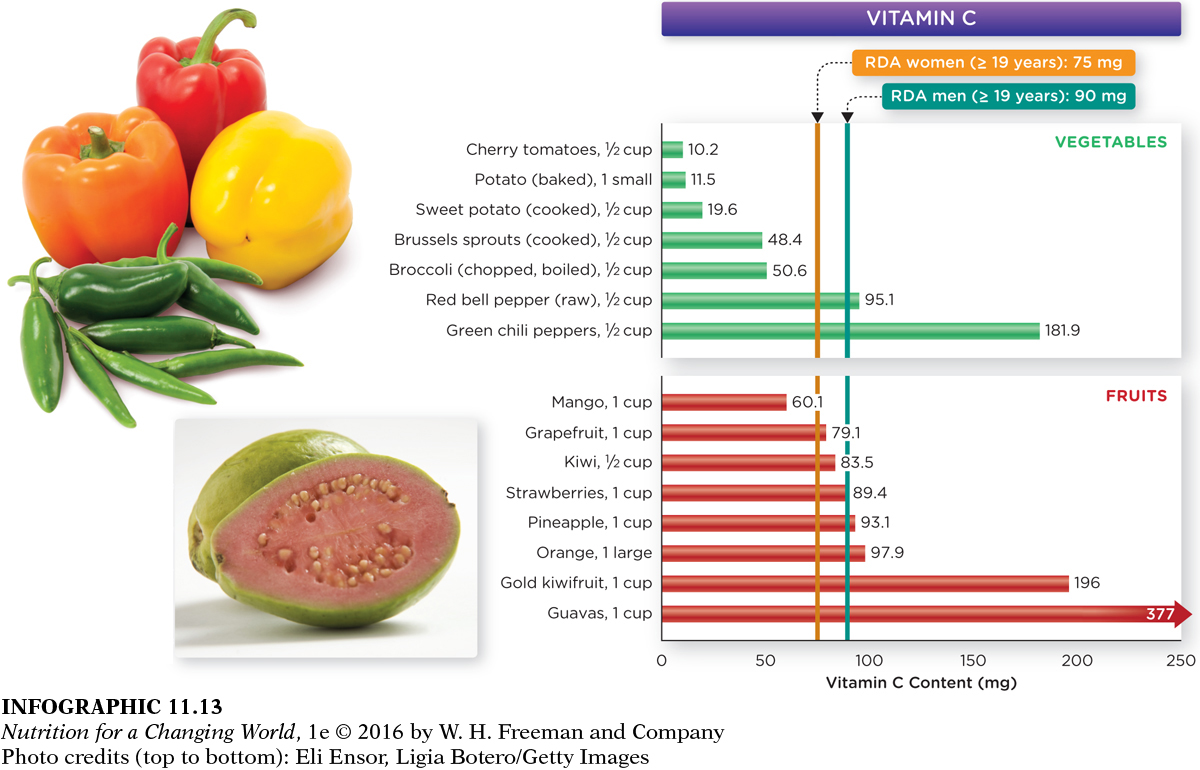VITAMIN C
SCURVY a disease caused by a deficiency of vitamin C resulting in bleeding gums, bruising, joint pain, and impaired wound healing

In the eighteenth and nineteenth centuries, as many as two million sailors were afflicted by a disease known as scurvy, a condition that causes anemia, bleeding gums, weakness, fatigue, joint pain, fragile bones, bruising, impaired wound healing, and immunity problems. In 1747, Scottish physician James Lind conducted a trial of six different treatments for 12 sailors with scurvy and found that only lemons and oranges were effective at curing the condition. These citrus fruits are rich in vitamin C; a deficiency of this water-
251

ANTIOXIDANT a substance that prevents damage to cells by inhibiting the oxidation caused by free radicals
Vitamin C, also known as ascorbic acid, acts as a coenzyme in biological reactions and aids in hormone production. It’s also involved in the synthesis of collagen, which is used to build bone, teeth, scar tissue, and arterial walls, and it enhances iron absorption. The majority of the signs associated with scurvy are caused by the inability to synthesize collagen appropriately, which causes blood vessels to leak, wounds to heal poorly, and gums to bleed. In addition, vitamin C functions as an antioxidant, a substance that prevents damage to cells by inhibiting the oxidation caused by free radicals, which can damage DNA and tissues.
Despite the old wives’ tales, vitamin C is not a cure for the common cold: A 2013 evaluation of published research on vitamin C concluded that “no consistent effect of vitamin C was seen on the duration or severity of colds in the therapeutic trials,” meaning that there is likely little benefit to taking vitamin C supplements once the symptoms of a cold are detected. In contrast, regular vitamin C supplementation may result in a very slight decrease in the duration of a cold by about 8% in children and 14% in adults. In individuals experiencing short-
252
Vitamin C is naturally found in citrus fruits, tomatoes, tomato juice, potatoes, Brussels sprouts, cauliflower, broccoli, strawberries, cabbage, and squash (INFOGRAPHIC 11.13). However, it is readily destroyed by storage and cooking. Potatoes and apples lose about 50% of their vitamin C content in 4 to 5 months of storage.

Consumption of vitamin C in excess of the UL, set at 2,000 mg for both men and women, may cause diarrhea and bloating, and it may increase the risk of kidney stones in people with kidney disease. The RDA is 90 mg for men 19 and older and 75 mg for women 19 and older. Because smokers are exposed to greater oxidative stress, and they have lower concentrations of vitamin C in the body, they are advised to increase their intake by another 35 mg over the RDA.
INFOGRAPHIC 11.14 shows a list of all of the water-

■ ■ ■
Scurvy, beriberi, and pellagra are diseases largely of the past, because of the work of the physicians, physiologists, and chemists who were pioneers in vitamin research. Although our understanding of vitamins and other nutrients in foods is ever-
253
254